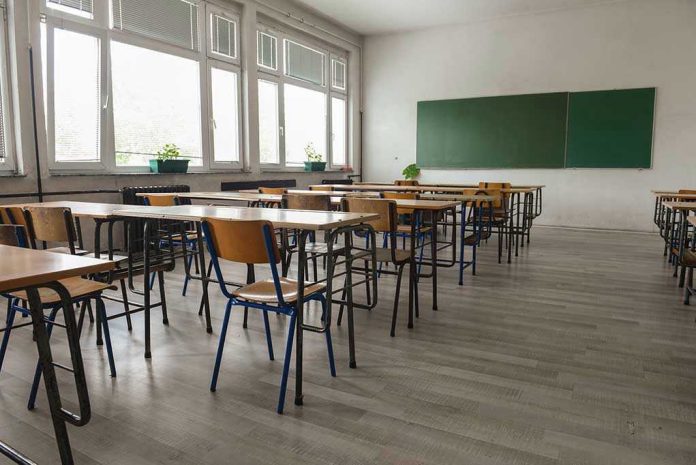
One in eight New York City public schoolchildren spent last year homeless, and if you think that’s just another grim statistic, consider how it’s quietly rewriting the city’s future, one classroom at a time.
Story Snapshot
- New York City’s public schools saw a record 146,733 homeless students in the 2023–24 school year—a 23% surge from last year.
- Student homelessness in NYC has exceeded 100,000 for nine straight years, fueled by housing shortages and a wave of migrant families.
- Advocates warn of deep educational and social impacts, with absenteeism and dropout rates climbing among homeless students.
- Community and policy leaders face mounting pressure to deliver urgent, targeted solutions.
Record-Breaking Homelessness Hits NYC Schools
New York City’s public school system—already the nation’s largest—is now grappling with the largest homeless student population ever recorded. Advocates for Children of New York revealed that in the 2023–24 school year, 146,733 students lacked stable housing, a figure representing one out of every eight schoolchildren. The number marks a staggering 23% spike over the previous year and continues a nine-year stretch where more than 100,000 students have lived without a permanent address.
Behind the numbers lies a complex web of causes. Chronic shortages of affordable housing and rising rents have haunted the city for decades, but the recent influx of asylum-seeking and migrant families has pushed the crisis into uncharted territory. Shelters and temporary housing options are stretched thin, with upper Manhattan, the southwest Bronx, and parts of Brooklyn seeing up to one in five students affected. These neighborhoods, already wrestling with economic hardship, now serve as epicenters for a new wave of educational disruption.
Educational Fallout: Disrupted Learning and Troubled Futures
Homelessness doesn’t just mean sleeping in a shelter or a car—it reverberates through every aspect of a child’s education. Students without stable homes are far more likely to miss school, transfer schools mid-year, and suffer academically. Chronic absenteeism, a reliable predictor of dropping out, is rampant among homeless students, setting them on a path toward reduced educational attainment and increased risk of homelessness as adults. Jennifer Pringle of Advocates for Children underscores the urgency: “Every day a student spends in temporary housing is a day their education is at risk.”
Schools in high-impact districts bear the brunt, with teachers and administrators scrambling to provide stability and support amid chaos. The educational sector faces a daunting challenge: how to ensure equity and opportunity for students whose lives are defined by uncertainty. Research consistently shows that students in temporary housing lag behind their peers in proficiency rates and graduation numbers, deepening cycles of poverty and limiting future prospects.
Policy, Advocacy, and the Battle for Solutions
Calls for action echo from advocacy groups, educators, and city officials alike. The NYC Department of Homeless Services and the Department of Education labor under mounting pressure to expand shelter capacity and provide tailored educational services. Advocacy organizations like AFC and NYS-TEACHS have become critical voices, pushing for reforms that tackle both immediate needs and the systemic roots of the crisis. Yet, resource constraints and political wrangling complicate progress, as leaders struggle to allocate funding and address public outcry.
Decision-makers—including the mayor, city council, and schools chancellor—face a pivotal moment. The surge in homeless students has made headlines, but behind the media coverage lies a quieter battle over priorities and values. Conservative perspectives emphasize the need for common-sense reforms, fiscal accountability, and targeted intervention, rather than blanket policy responses. The debate is not about whether to act, but how best to balance compassion, effectiveness, and sustainable change.
Ripple Effects: Social, Economic, and Political Consequences
Student homelessness in NYC is not an isolated tragedy; it’s a force reshaping the city’s social and economic landscape. Schools and communities endure strained resources, while the broader public faces the consequences of rising intergenerational poverty and social inequality. The political stakes are high, with city and state leaders held to account for both the crisis and the solutions they pursue. If the past nine years have shown anything, it’s that ignoring the problem only deepens its roots.
Expert analysis from organizations like Advocates for Children and NYS-TEACHS leaves little doubt: the crisis is real, growing, and demands urgent intervention. Differences persist over the relative impact of migration versus longstanding housing failures, but the consensus is clear—both fuel the crisis, and solving it will require multifaceted, evidence-based approaches. The fate of 146,733 children—and the very fabric of the city—hangs in the balance.
Sources:
Advocates for Children of New York
Advocates for Children of New York







